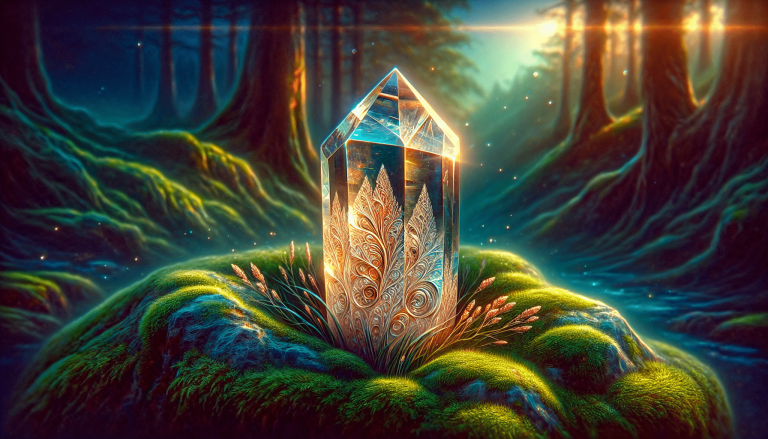Eco-friendly Options For Using Natural Dyes And Pigments In Spiritual Arts And Crafts
In the realm of spiritual arts and crafts, embracing sustainability has become increasingly important. If you’re someone who values eco-friendly practices and seeks to bring that essence into your creative endeavors, exploring the world of natural dyes and pigments is a fantastic option. By utilizing materials sourced from nature, you can delve into a realm of vibrant, earthy hues that not only enhance your artistic expressions but also maintain a deep connection to the environment. Discovering these eco-friendly options allows you to infuse your spiritual crafts with a touch of sustainability, leaving a positive impact on both your creations and the world around you.
Benefits of Using Natural Dyes and Pigments
Using natural dyes and pigments not only enhances the beauty and aesthetics of your artwork, but it also offers a range of benefits for both the environment and your health. Let’s explore some of the major advantages:
Reduction in Environmental Impact
One of the biggest advantages of using natural dyes and pigments is the significant reduction in environmental impact. Unlike synthetic dyes, which are often derived from harsh chemicals and pollutants, natural dyes are sourced from renewable resources such as plants, insects, and minerals. This means that the extraction process is less harmful to the environment and reduces air and water pollution. By choosing natural dyes, you are making a conscious decision to minimize your carbon footprint and contribute to a cleaner and greener planet.
Health Benefits
Another great benefit of using natural dyes and pigments is the positive impact it can have on your health. Synthetic dyes often contain toxic substances that can lead to allergies, respiratory issues, and even skin irritations. On the other hand, natural dyes are generally non-toxic and hypoallergenic, making them a safer alternative for individuals with sensitive skin or chemical sensitivities. By using natural dyes, you can enjoy the creative process without compromising your well-being.
Spiritual Connection
Using natural dyes and pigments can also deepen your spiritual connection to art and craft. Many cultures and spiritual practices view natural materials as sacred and imbued with spiritual energy. By incorporating natural dyes into your artwork, you not only create beautiful pieces but also tap into the natural world’s inherent wisdom and energy. This spiritual connection can add an extra layer of meaning and intention to your creations, making them more meaningful and fulfilling.
Natural Dye Extraction Methods
Now that we understand the benefits of using natural dyes and pigments, let’s delve into the different methods of extracting them. Natural dyes can be derived from various sources, including plants, insects, and minerals. Each extraction method offers unique colors and characteristics, giving you a wide range of options to explore.
Plant-Based Dyes
Plant-based dyes are perhaps the most commonly used natural dyes. They are derived from various parts of plants, such as leaves, flowers, stems, and roots. Plants like indigo, turmeric, and madder root are popular sources of plant-based dyes. The extraction process involves simmering the plant material in water, which helps release the pigments. The resulting dye can be used to create a vast array of colors, ranging from earthy tones to vibrant hues.
Insect-Based Dyes
Insect-based dyes, as the name suggests, are derived from insects. One of the most famous examples is cochineal, a red dye made from dried female cochineal insects. These insects are found on cacti in regions like Mexico and Central America. The extraction process involves grinding the dried insects into a fine powder, which is then mixed with water or another medium to create the dye. Insect-based dyes offer unique and intense colors, particularly in the red and purple spectrum.
Mineral-Based Dyes
Mineral-based dyes are derived from various minerals, such as iron oxide, ochre, and malachite. These dyes are often found in the form of earth pigments, which can be ground into fine powders. The extraction process generally involves grinding the mineral into a powder and mixing it with a binder, such as gum arabic, for application. Mineral-based dyes are known for their vibrant and long-lasting colors, making them a popular choice for artists looking to create bold and striking pieces.
Plant-Based Dyes
Plant-based dyes offer a wide range of colors and are easily accessible. Let’s take a closer look at the sources, extraction process, and color variations of plant-based dyes.
Sources of Plant-Based Dyes
Plant-based dyes can be derived from a variety of plants, each offering unique colors. Some common sources include indigo, turmeric, madder root, onion skins, and marigold flowers. These plants contain natural pigments that can be extracted and used to dye fabrics, yarns, and other materials.
Extraction Process
The extraction process for plant-based dyes typically involves simmering the desired plant material in water. This helps release the pigments and create a dye bath. The fabric or material to be dyed is then immersed in the dye bath, allowing the color to penetrate and bind to the fibers. The duration of the dyeing process can vary depending on the desired color intensity.
Color Variations
Plant-based dyes offer a vast range of color possibilities. For example, indigo produces rich blues, while turmeric provides vibrant yellows. Madder root offers a palette of reds and pinks, whereas onion skins can yield warm golden hues. Marigold flowers can be used to create beautiful orange and yellow tones. Each plant has its unique color variations, allowing you to experiment and create a diverse range of hues.
Insect-Based Dyes
Insect-based dyes are intriguing and can offer stunning, intense colors. Let’s explore the sources of insect-based dyes, the extraction process, and the unique color range they provide.
Sources of Insect-Based Dyes
One of the most well-known sources of insect-based dyes is cochineal, derived from dried female cochineal insects found on cacti. These insects produce a vibrant red dye that has been used for centuries. Other sources of insect-based dyes include lac insects, found on trees in Southeast Asia, which produce deep reds and dark purples. These insects’ unique properties make them highly desirable for dyeing purposes.
Extraction Process
The extraction process for insect-based dyes typically involves grinding the dried insects into a fine powder. This powder is then mixed with water or another solvent to create a dye solution. The resulting dye can be applied to fabrics and materials, creating intense and captivating colors. The extraction process may vary slightly depending on the specific insect and dye being used.
Unique Color Range
Insect-based dyes offer a distinctive color range, particularly in the red and purple spectrum. Cochineal, for example, provides rich and vibrant reds that can range from deep maroons to bright scarlets. Lac insects, on the other hand, yield deep reds and dark purples, perfect for creating dramatic and richly colored artworks. These insect-based dyes offer a unique and natural alternative to synthetic dyes, adding depth and character to your creations.
Mineral-Based Dyes
Mineral-based dyes offer vibrant and long-lasting colors, making them a popular choice among artists. Let’s explore the sources of mineral-based dyes, the extraction process, and their vibrant characteristics.
Sources of Mineral-Based Dyes
Mineral-based dyes are derived from various minerals found in nature. Common sources include iron oxide, which provides earthy red, brown, and orange hues. Ochre, a natural clay pigment, offers yellow, red, and brown shades. Malachite, a green mineral, can be ground into a powder to create vibrant greens and blues. These minerals provide a diverse range of colors that can transform your artwork with their natural beauty.
Extraction Process
The extraction process for mineral-based dyes generally involves grinding the mineral into a fine powder. This powder can then be mixed with a binder, such as gum arabic or a medium, to create a paint-like consistency. The color is then applied to the desired surface using brushes, fingers, or other application techniques. The simplicity of the extraction process makes mineral-based dyes accessible and allows artists to experiment freely with their vibrant hues.
Vibrant and Long-Lasting Colors
One of the key benefits of using mineral-based dyes is their ability to produce vibrant and long-lasting colors. Unlike synthetic dyes that can fade over time, mineral-based dyes are known for their durability and resistance to fading. This quality ensures that your artwork retains its brilliance and intensity for years to come. Whether you’re painting, dyeing fabrics, or creating other artistic pieces, mineral-based dyes offer a reliable and beautiful option.
Sustainable Pigment Options
In addition to natural dyes, there are also sustainable pigment options available. These pigments are derived from various sources and offer unique characteristics. Let’s explore some popular sustainable pigment options: natural earth pigments, contemporary eco-pigments, and vegetable and fruit pigments.
Natural Earth Pigments
Natural earth pigments are derived from minerals found in the earth’s crust. These minerals are mined and processed into fine powders that can be mixed with a binder to create a paint or dye. Natural earth pigments offer a wide variety of colors, including browns, yellows, reds, and blues. They have been used for centuries in various forms of art and are known for their stability and permanence.
Contemporary Eco-Pigments
Contemporary eco-pigments are pigments specifically designed to minimize environmental impact. These pigments are often made from bio-based materials or recycled sources. Bio-based pigments utilize organic materials such as algae, bacteria, or fungi to create vibrant colors. Recycled pigments, on the other hand, are derived from discarded materials like plastic or waste pigment residue. These eco-pigments are a great alternative for artists who want to create stunning artwork while minimizing their ecological footprint.
Vegetable and Fruit Pigments
Vegetable and fruit pigments offer a unique and natural alternative for creating vibrant colors. These pigments are obtained by extracting the colorful compounds found in fruits and vegetables. For example, beets can be used to create a lovely shade of pink, while spinach or kale can yield beautiful greens. Using vegetable and fruit pigments allows you to experiment with a wide range of colors while embracing the sustainable and organic nature of these materials.
Natural Earth Pigments
Natural earth pigments have a rich history and offer a plethora of colors for artists and crafters. Let’s explore the variety of colors available, sourcing and preparation methods, and application techniques for natural earth pigments.
Variety of Colors
Natural earth pigments offer a diverse range of colors that can be used to create stunning and nuanced artwork. These pigments can be found in various hues of browns, reds, yellows, and blues. Each color has its unique characteristics, allowing artists to create depth and dimension in their work. Whether you’re painting a landscape, creating abstract art, or practicing traditional techniques, natural earth pigments provide a broad palette to explore.
Sourcing and Preparation
Natural earth pigments are typically sourced from mineral deposits found in different regions of the world. These minerals are carefully processed and ground into fine powders to create pigments. They can be purchased from specialty suppliers or even collected directly from certain natural sites. Before use, natural earth pigments may require further preparation, such as mixing with a binder or grinding into a finer consistency.
Application Techniques
Natural earth pigments can be applied using various techniques, depending on the desired effect. They can be mixed with a binder to create paints, used dry for dry brush techniques, or even mixed with water for a watercolor-like application. The versatility of natural earth pigments allows artists to explore different textures, brushstrokes, and layering techniques. Their stability and permanence ensure that your artwork will retain its vibrancy and integrity over time.
Contemporary Eco-Pigments
Contemporary eco-pigments are a sustainable and environmentally friendly option for artists. Let’s explore the different types of contemporary eco-pigments, their benefits, and how they can be used in artwork.
Bio-based Pigments
Bio-based pigments are derived from organic materials such as algae, bacteria, or fungi. These pigments offer a wide range of colors, from vibrant blues and greens to earthy browns and yellows. One of the significant benefits of using bio-based pigments is their renewable nature. Unlike traditional pigments that rely on mineral extraction, bio-based pigments can be sustainably cultivated and harvested. By using bio-based pigments, artists can create stunning artwork while minimizing their ecological impact.
Recycled Pigments
Recycled pigments are another innovative and eco-friendly option for artists. These pigments are derived from various sources, including discarded materials, waste pigment residue, or even recycled plastics. By repurposing these materials, artists can contribute to reducing waste and creating new value from existing resources. Despite their recycled nature, these pigments can offer vibrant and interesting coloring options. Using recycled pigments encourages sustainability in art and highlights the importance of upcycling in creative practices.
Low-Impact Synthetic Pigments
While natural and eco-friendly options are preferable, low-impact synthetic pigments can also be considered as an alternative to traditional synthetic dyes and pigments. Low-impact synthetics are dyes made with a reduced environmental footprint, considering factors such as energy consumption, water usage, and waste generation during the manufacturing process. These pigments are designed to minimize harm to the environment while still offering a broad range of colors and characteristics. When choosing low-impact synthetic pigments, make sure to research the manufacturing process and choose products from reputable and environmentally conscious manufacturers.
Vegetable and Fruit Pigments
Vegetable and fruit pigments offer a vibrant and sustainable option for artists looking to incorporate natural colors into their artwork. Let’s explore the benefits of using vegetable and fruit pigments, the process of extracting them, and how they can be utilized in art and craft projects.
Benefits of Using Vegetable and Fruit Pigments
Using vegetable and fruit pigments in your artwork offers numerous benefits. Firstly, these pigments are derived from natural and renewable sources, making them an eco-friendly choice. Additionally, using vegetable and fruit pigments allows you to create a wide range of vibrant colors that are not easily achievable with synthetic pigments. Moreover, these pigments often have a unique and organic quality that adds depth and texture to your artwork. By utilizing vegetable and fruit pigments, you can create visually stunning pieces while embracing sustainability.
Natural Dye Extraction Process
The process of extracting pigments from vegetables and fruits involves various techniques, including boiling, fermenting, or soaking the plant material. The pigments are released during this process and can be collected to create dyes or used directly for painting or coloring purposes. Each vegetable and fruit may require a different extraction method, so it’s important to research and experiment to achieve the desired color and intensity.
Utilization in Art and Craft Projects
Vegetable and fruit pigments can be utilized in a wide range of art and craft projects. From painting and dyeing fabrics to creating handmade papers or natural inks, the possibilities are endless. These pigments can be used to add vibrant colors to artworks, enhance natural elements in crafts, or even create unique patterns and designs. The inherent organic qualities of vegetable and fruit pigments also add a touch of authenticity and connection to nature in your creative endeavors.
Tips for Successful Use of Natural Dyes and Pigments
To ensure successful and satisfying results when using natural dyes and pigments in your artwork, consider the following tips:
Preparation and Pretreatment of Fabrics
When working with natural dyes, it’s essential to properly prepare and pretreat the fabrics or materials you intend to dye. This may involve washing and mordanting the fabric to ensure better dye absorption and color vibrancy. Mordants such as alum, iron, or tannin can be used to improve colorfastness and enhance the dye’s bond with the fibers. Research the specific requirements of the chosen dye and fabric to achieve the best results.
Understanding Colorfastness
Colorfastness refers to the ability of a dye to retain its hue and resist fading or bleeding over time. It’s important to understand the colorfastness of the natural dyes you are using to ensure the longevity of your artwork. Some dyes may require additional steps such as post-dye treatments or using fixatives to enhance colorfastness. Consider conducting colorfastness tests on sample fabrics or materials before committing to your final artwork.
Exploring Different Mordants
Mordants play a crucial role in the natural dyeing process, as they help fix the dye to the fabric and enhance color intensity. Experimenting with different mordants can yield a broad range of color variations and effects. For example, using aluminum acetate as a mordant can produce brighter and more vibrant colors, while iron mordants can create deep and muted tones. Explore different mordant options to expand your color palette and enhance the uniqueness of your artwork.
By following these tips, you can create stunning and meaningful artwork while maximizing the benefits of using natural dyes and pigments. Whether you’re exploring plant-based dyes, insect-based dyes, or mineral-based dyes, embracing sustainable pigment options, or unleashing the vibrant colors of vegetable and fruit pigments, your creations will embody the harmony between art and nature. With natural dyes and pigments, you can forge a deeper connection with the environment, celebrate its beauty, and contribute to a more eco-friendly artistic practice.








